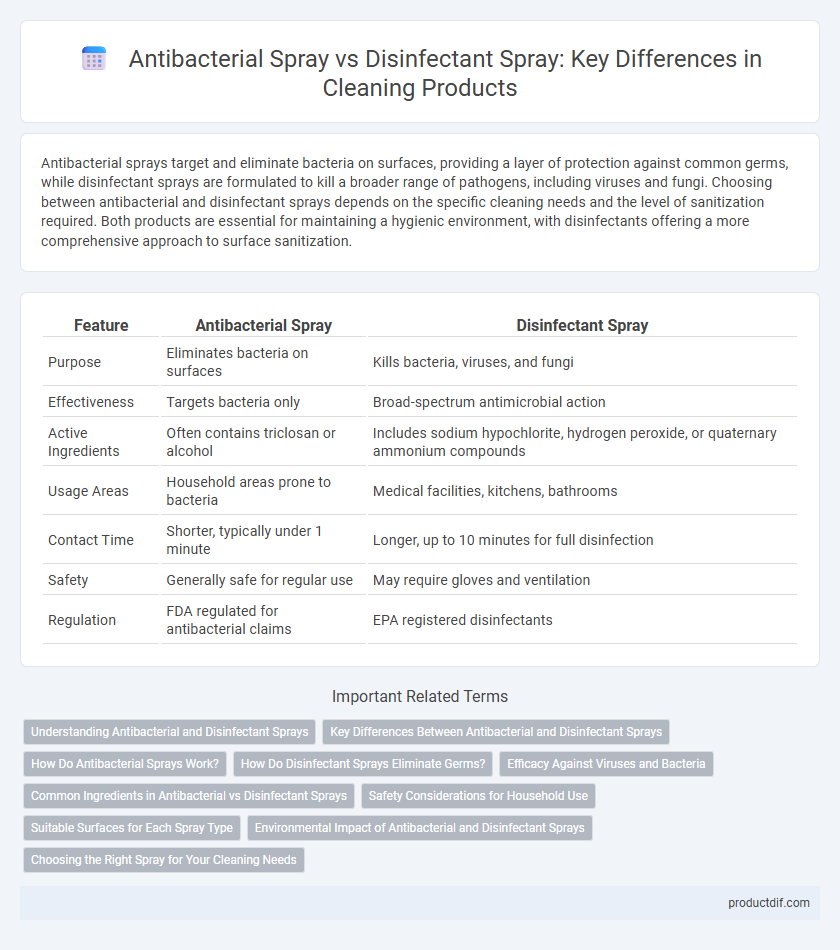Antibacterial sprays target and eliminate bacteria on surfaces, providing a layer of protection against common germs, while disinfectant sprays are formulated to kill a broader range of pathogens, including viruses and fungi. Choosing between antibacterial and disinfectant sprays depends on the specific cleaning needs and the level of sanitization required. Both products are essential for maintaining a hygienic environment, with disinfectants offering a more comprehensive approach to surface sanitization.
Table of Comparison
| Feature | Antibacterial Spray | Disinfectant Spray |
|---|---|---|
| Purpose | Eliminates bacteria on surfaces | Kills bacteria, viruses, and fungi |
| Effectiveness | Targets bacteria only | Broad-spectrum antimicrobial action |
| Active Ingredients | Often contains triclosan or alcohol | Includes sodium hypochlorite, hydrogen peroxide, or quaternary ammonium compounds |
| Usage Areas | Household areas prone to bacteria | Medical facilities, kitchens, bathrooms |
| Contact Time | Shorter, typically under 1 minute | Longer, up to 10 minutes for full disinfection |
| Safety | Generally safe for regular use | May require gloves and ventilation |
| Regulation | FDA regulated for antibacterial claims | EPA registered disinfectants |
Understanding Antibacterial and Disinfectant Sprays
Antibacterial sprays target and eliminate bacteria, primarily focusing on preventing bacterial growth on surfaces, making them ideal for everyday cleaning tasks. Disinfectant sprays have a broader spectrum, effectively killing bacteria, viruses, and fungi, which is essential for sterilizing areas prone to contamination or infection. Understanding the specific microbial coverage and intended use of each product ensures proper application for maintaining hygiene and preventing illness.
Key Differences Between Antibacterial and Disinfectant Sprays
Antibacterial sprays primarily target bacteria by inhibiting their growth or killing them, while disinfectant sprays eliminate a broader range of pathogens including bacteria, viruses, and fungi. Antibacterial sprays are often used for routine cleaning on skin and non-porous surfaces, whereas disinfectant sprays are designed for high-risk areas like hospitals to ensure comprehensive sterilization. The efficacy of disinfectant sprays is typically tested and proven against strict regulatory standards, making them essential for controlling the spread of infectious diseases.
How Do Antibacterial Sprays Work?
Antibacterial sprays target and eliminate bacteria by disrupting their cell walls or interfering with essential enzymes, effectively inhibiting bacterial growth and reproduction. These sprays often contain active agents like triclosan or benzalkonium chloride, designed to kill or inhibit specific bacterial strains without affecting viruses or fungi. Understanding the mode of action highlights why antibacterial sprays are ideal for reducing bacterial contamination on surfaces but are less effective against a broader spectrum of pathogens compared to disinfectant sprays.
How Do Disinfectant Sprays Eliminate Germs?
Disinfectant sprays eliminate germs by using active chemical agents like alcohol, quaternary ammonium compounds, or hydrogen peroxide that destroy the cell walls of bacteria, viruses, and fungi. These sprays penetrate microbial membranes, denature proteins, and disrupt essential cellular functions, leading to the death of harmful pathogens on surfaces. Unlike antibacterial sprays that primarily target bacteria, disinfectant sprays provide broad-spectrum efficacy against a wide range of microorganisms, ensuring more comprehensive sanitation.
Efficacy Against Viruses and Bacteria
Antibacterial sprays primarily target bacteria by disrupting cell walls and inhibiting growth, making them effective against common bacterial pathogens but less potent against viruses. Disinfectant sprays contain broader-spectrum chemicals approved by the EPA to eliminate a wider range of microorganisms, including both bacteria and viruses such as influenza and coronavirus. The efficacy of disinfectant sprays against enveloped and non-enveloped viruses makes them a more comprehensive choice for reducing viral and bacterial contamination on surfaces.
Common Ingredients in Antibacterial vs Disinfectant Sprays
Antibacterial sprays commonly contain active ingredients such as triclosan, benzalkonium chloride, and chlorhexidine, targeting specific bacteria to inhibit their growth. Disinfectant sprays typically include stronger agents like sodium hypochlorite, hydrogen peroxide, or quaternary ammonium compounds, designed to eliminate a broader spectrum of pathogens including viruses and fungi. The choice between antibacterial and disinfectant sprays depends on the required level of microbial control and the target surfaces.
Safety Considerations for Household Use
Antibacterial sprays target bacteria specifically, often containing active ingredients like triclosan or benzalkonium chloride, which require careful use to avoid skin irritation and antibiotic resistance. Disinfectant sprays, formulated with agents such as sodium hypochlorite or hydrogen peroxide, eliminate a broader spectrum of pathogens but must be used in well-ventilated areas to prevent inhalation risks and surface damage. For household safety, follow label instructions, store out of children's reach, and avoid mixing products to reduce toxic exposure and ensure effective microbial control.
Suitable Surfaces for Each Spray Type
Antibacterial sprays are best suited for non-porous surfaces like countertops, door handles, and bathroom fixtures, where they effectively reduce bacteria without causing damage. Disinfectant sprays are formulated to eliminate a wider range of pathogens on high-touch surfaces such as kitchen sinks, cutting boards, and medical equipment, including viruses and fungi. Choosing the right spray depends on the surface material and desired level of microbial control to ensure both safety and effectiveness.
Environmental Impact of Antibacterial and Disinfectant Sprays
Antibacterial sprays often contain chemical agents such as triclosan and quaternary ammonium compounds, which can persist in water systems and contribute to antibiotic resistance, raising concerns about their environmental impact. Disinfectant sprays typically utilize stronger biocidal chemicals like bleach or hydrogen peroxide, which break down more rapidly but may still harm aquatic life if overused or improperly disposed of. Choosing eco-friendly formulations with biodegradable ingredients and minimal toxic residues can significantly reduce the ecological footprint of both antibacterial and disinfectant sprays.
Choosing the Right Spray for Your Cleaning Needs
Antibacterial sprays target and eliminate bacteria, making them ideal for everyday use on surfaces like kitchen counters and bathroom sinks where germs accumulate frequently. Disinfectant sprays provide a broader spectrum of protection by killing bacteria, viruses, and fungi, making them essential for high-risk areas such as hospitals or during flu seasons. Selecting the right spray depends on the level of contamination and desired protection, with antibacterial sprays suited for routine cleaning and disinfectant sprays recommended for thorough sanitization.
Antibacterial spray vs Disinfectant spray Infographic

 productdif.com
productdif.com